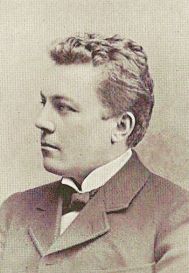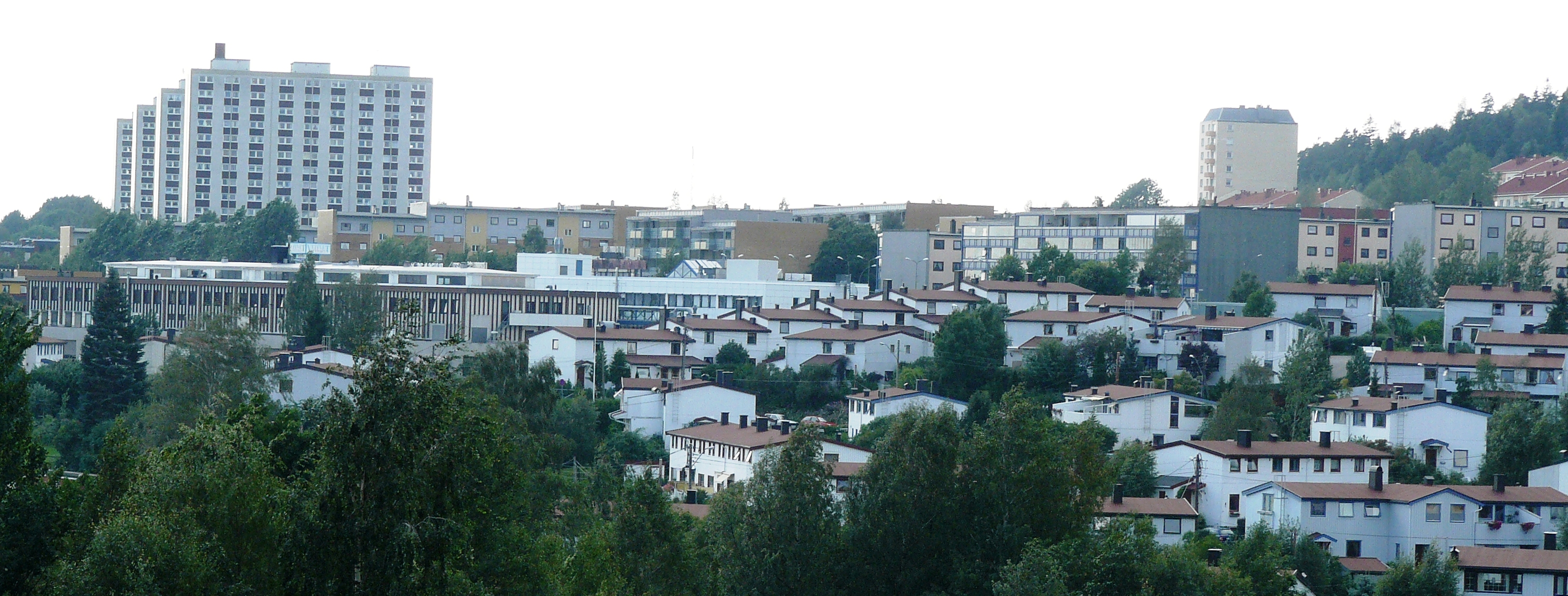|
Christian Pierre Mathiesen
Christian Pierre Mathiesen (14 April 1870 – 8 August 1953) was a Norwegian landowner and politician for the Conservative Party. Background He was born in Kristiania (now Oslo), Norway, as the youngest son of landowner and industrialist Haaken C. Mathiesen. He finished his secondary education in 1888, graduated from the agricultural school at Sem in 1890 and also took agricultural education in Denmark. He was the owner of Linderud Manor from 1893, while his oldest brother Haaken L. Mathiesen inherited the family company Mathiesen Eidsvold Værk. In 1940 he passed Linderud Manor down to his nephew, another Mathiesen Eidsvold Værk inheritor, Jørgen Mathiesen. Career Having many political positions in Aker, Mathiesen was elected to the Parliament of Norway in 1900 from the constituency Akershus Amt. He served one term. On 22 October 1903, when the Hagerup's Second Cabinet assumed office, he was appointed as the new Minister of Agriculture. He lasted until 25 September 1904, w ... [...More Info...] [...Related Items...] OR: [Wikipedia] [Google] [Baidu] |
Christian P
Christians () are people who follow or adhere to Christianity, a monotheistic Abrahamic religion based on the life and teachings of Jesus Christ. The words ''Christ'' and ''Christian'' derive from the Koine Greek title ''Christós'' (Χριστός), a translation of the Biblical Hebrew term ''mashiach'' (מָשִׁיחַ) (usually rendered as ''messiah'' in English). While there are diverse interpretations of Christianity which sometimes conflict, they are united in believing that Jesus has a unique significance. The term ''Christian'' used as an adjective is descriptive of anything associated with Christianity or Christian churches, or in a proverbial sense "all that is noble, and good, and Christ-like." It does not have a meaning of 'of Christ' or 'related or pertaining to Christ'. According to a 2011 Pew Research Center survey, there were 2.2 billion Christians around the world in 2010, up from about 600 million in 1910. Today, about 37% of all Christians live in the Amer ... [...More Info...] [...Related Items...] OR: [Wikipedia] [Google] [Baidu] |
Linderud
Linderud is a neighborhood in Bjerke borough, Oslo, Norway. The area originally formed part of the estate of Linderud Manor. Linderud Manor Linderud Manor ''(Linderud gård'') was owned by the Catholic Church before the Reformation of 1536, and thereafter by the Crown. It was bought by Peder Griffenfeldt in 1673, then by Mogens Lauritzen in 1679, and belonged to the latter's family for over a century. By the late eighteenth century, the manor was a part of a property which included vast amounts of forest, some timber industrial sites and about 350 farms. Lauritzen's ancestor Mogens Larsen Monsen passed it down to his son-in-law Haagen Mathiesen in 1802. Later owners include Haaken C. Mathiesen from 1875 to 1891, Christian Pierre Mathiesen from 1893 to 1940 and Jørgen Mathiesen from 1940. Jørgen Mathiesen set up the Linderud Foundation in 1954, which now owns the main building of the manor as well as the surrounding park. Since 1960 parts of the park are preserved due to botan ... [...More Info...] [...Related Items...] OR: [Wikipedia] [Google] [Baidu] |
Forsikringsselskapet Norden
Forsikringsselskapet Norden was a general insurance company based in Norway. It was founded as ''Brandforsikringsselskabet Norden'' on 4 April 1867, and began operating on 2 September the same year. Its first offices were located in ''Karl Johans gate 14''. The main driving forces behind the foundation were Carl Ferdinand Gjerdrum and Jacob Thurmann Ihlen, who became the first chief executive and first chair respectively. Gjerdrum served until 1887 and Ihlen to 1904. The next chief executive was L. S. Karlsen from 1887 to 1933; he was succeeded by Harald Sommerfeldt. From 1958 to 1971 Erik Ø. Poulsson was at the helm. In 1970 the company announced plans to form the holding company Nordengruppen together with the insurance companies Sigyn and Norske Alliance. The cooperation finally materialized in September 1971. The three companies continued as semi-independent, but under a common board of directors. In Nordengruppen, the former shareholders in Norden got 64% of the shares w ... [...More Info...] [...Related Items...] OR: [Wikipedia] [Google] [Baidu] |
Akers Sparebank
{{disambiguation, geo ...
Akers may refer to: People *Akers (surname) Places In the United States: *Akers, Missouri, in Shannon County *Akers Pond in New Hampshire * Akers, Louisiana Other uses *Akers' clasp, for removable partial dentures See also *Aker (other) *Acker *Ackers Ackers is a surname. People with this surname include: * Andy Ackers (born 1993), British rugby player * Benjamin St John Ackers (1839–1915), British Member of Parliament (MP) for West Gloucestershire, 1885 * Gary Ackers (1939–2011), American p ... [...More Info...] [...Related Items...] OR: [Wikipedia] [Google] [Baidu] |
Government
A government is the system or group of people governing an organized community, generally a state. In the case of its broad associative definition, government normally consists of legislature, executive, and judiciary. Government is a means by which organizational policies are enforced, as well as a mechanism for determining policy. In many countries, the government has a kind of constitution, a statement of its governing principles and philosophy. While all types of organizations have governance, the term ''government'' is often used more specifically to refer to the approximately 200 independent national governments and subsidiary organizations. The major types of political systems in the modern era are democracies, monarchies, and authoritarian and totalitarian regimes. Historically prevalent forms of government include monarchy, aristocracy, timocracy, oligarchy, democracy, theocracy, and tyranny. These forms are not always mutually exclusive, and mixed govern ... [...More Info...] [...Related Items...] OR: [Wikipedia] [Google] [Baidu] |
Johan Egeberg Mellbye
Johan Egeberg Mellbye (11 November 1866 – 17 December 1954) was a Norwegian farmer and politician who served as the first leader of the Norwegian Norwegian, Norwayan, or Norsk may refer to: *Something of, from, or related to Norway, a country in northwestern Europe * Norwegians, both a nation and an ethnic group native to Norway * Demographics of Norway *The Norwegian language, including ... Centre Party from 1920–1921. He also served as Minister of Agriculture 1904–1905, then representing the Conservative Party. His son Jan E. Mellbye ran the family farm and became chairman of the Norwegian Agrarian Association and Selskapet Ny Jord. References 1866 births 1954 deaths Government ministers of Norway Ministers of Agriculture and Food of Norway Honorary Knights Commander of the Royal Victorian Order {{Norway-politician-1860s-stub ... [...More Info...] [...Related Items...] OR: [Wikipedia] [Google] [Baidu] |
Minister Of Agriculture (Norway)
The Minister of Agriculture and Food ( no, Landbruks- og matministeren) is a councilor of state and chief of the Norway's Ministry of Agriculture and Food. The ministry is responsible for issues related to agriculture, forestry and food. Major subordinate agencies include the Norwegian Agriculture Authority, the Norwegian Food Safety Authority and Statskog. The position was created on 31 March 1900, along with the ministry, and Ole Anton Qvam was the inaugural officeholder. Fifty people from eight parties have held the office. During the German occupation of Norway from 1940 to 1945, the office was both held by a German puppet government and an elected government in London. Until 2004 the position was known as the Minister of Agriculture. The longest-serving officeholder is Hans Ystgaard, who served for more than ten years under Prime Minister Johan Nygaardsvold, who himself holds the shortest tenure, of sixteen days. Gunhild Øyangen has served for more than nine years, and was a ... [...More Info...] [...Related Items...] OR: [Wikipedia] [Google] [Baidu] |
Hagerup's Second Cabinet
The Hagerup's Second Cabinet governed Norway between 22 October 1903 and 11 March 1905. It fell as the cabinet ministers collectively resigned on 28 February and 1 March 1905, as part of the build-up for the dissolution of the union between Norway and Sweden in 1905. Christian Michelsen withdrew his application, and could form the cabinet Michelsen. It had the following composition: Cabinet members Unless otherwise noted, the period was 22 October 1903 - 11 March 1905 State Secretary Not to be confused with the modern title State Secretary. The old title State Secretary, used between 1814 and 1925, is now known as Secretary to the Government (''Regjeringsråd''). [...More Info...] [...Related Items...] OR: [Wikipedia] [Google] [Baidu] |
Parliament Of Norway
The Storting ( no, Stortinget ) (lit. the Great Thing) is the supreme legislature of Norway, established in 1814 by the Constitution of Norway. It is located in Oslo. The unicameral parliament has 169 members and is elected every four years based on party-list proportional representation in nineteen multi-seat constituencies. A member of Stortinget is known in Norwegian as a ''stortingsrepresentant'', literally "Storting representative". The assembly is led by a president and, since 2009, five vice presidents: the presidium. The members are allocated to twelve standing committees as well as four procedural committees. Three ombudsmen are directly subordinate to parliament: the Parliamentary Intelligence Oversight Committee and the Office of the Auditor General. Parliamentarianism was established in 1884, with the Storting operating a form of "qualified unicameralism", in which it divided its membership into two internal chambers making Norway a de facto bicameral parliament ... [...More Info...] [...Related Items...] OR: [Wikipedia] [Google] [Baidu] |
Aker, Norway
Aker was a former independent municipality in Akershus, Norway, that constitutes the vast majority of the territory of the modern city of Oslo. The name originally belonged to a farm which was located near the current Old Aker Church. The church in turn became the source of the name of the parish and later municipality as well as Akershus Fortress, the main fief and main county of Akershus which included most of Eastern Norway until 1919, the smaller county of Akershus, and numerous institutions within this area. Aker municipality was in terms of population by far the largest municipality of Akershus county and surrounded the capital city of Christiania (renamed Oslo in 1925) until 1948; Aker was 27 times larger than the capital it surrounded. In the late 19th century Aker ceded some of its territory to Christiania, and in 1948 Aker merged completely with Oslo municipality to create the modern, vastly enlarged Oslo municipality. The merger was unpopular in Aker, which at the time ... [...More Info...] [...Related Items...] OR: [Wikipedia] [Google] [Baidu] |





